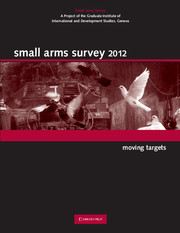Book contents
- Frontmatter
- Foreword
- Contents
- About the Small Arms Survey
- Notes to readers
- Acknowledgements
- Introduction
- Chapter 1 A Fatal Relationship: Guns and Deaths in Latin America and the Caribbean
- Chapter 2 When Business Gets Bloody: State Policy and Drug Violence
- Chapter 3 A Matter of Survival: Non-lethal Firearm Violence
- Chapter 4 Blue Skies and Dark Clouds: Kazakhstan and Small Arms
- Chapter 5 Between State and Non-state: Somaliland's Emerging Security Order
- Photo Essay. Troubled Waters: Somali Piracy
- Chapter 6 Escalation at Sea: Somali Piracy and Private Security Companies
- Chapter 7 Precedent in the Making: The UN Meeting of Governmental Experts
- Chapter 8 Piece by Piece: Authorized Transfers of Parts and Accessories
- Chapter 9 Point by Point: Trends in Transparency
- Chapter 10 Surveying the Battlefield: Illicit Arms in Afghanistan, Iraq, and Somalia
- Index
Chapter 5 - Between State and Non-state: Somaliland's Emerging Security Order
Published online by Cambridge University Press: 05 February 2015
- Frontmatter
- Foreword
- Contents
- About the Small Arms Survey
- Notes to readers
- Acknowledgements
- Introduction
- Chapter 1 A Fatal Relationship: Guns and Deaths in Latin America and the Caribbean
- Chapter 2 When Business Gets Bloody: State Policy and Drug Violence
- Chapter 3 A Matter of Survival: Non-lethal Firearm Violence
- Chapter 4 Blue Skies and Dark Clouds: Kazakhstan and Small Arms
- Chapter 5 Between State and Non-state: Somaliland's Emerging Security Order
- Photo Essay. Troubled Waters: Somali Piracy
- Chapter 6 Escalation at Sea: Somali Piracy and Private Security Companies
- Chapter 7 Precedent in the Making: The UN Meeting of Governmental Experts
- Chapter 8 Piece by Piece: Authorized Transfers of Parts and Accessories
- Chapter 9 Point by Point: Trends in Transparency
- Chapter 10 Surveying the Battlefield: Illicit Arms in Afghanistan, Iraq, and Somalia
- Index
Summary
INTRODUCTION
Just a few years after declaring independence in 1991, Somaliland experienced large-scale armed conflict. Yet, in contrast to south-central Somalia, security in Somaliland was relatively stable in 2011. How has the de facto state managed to achieve a comparatively high level of security despite its recent history of violent conflict and the widespread civilian possession of military firearms?
Some analysts claim that the home-grown disarmament, demobilization, and reintegration (DDR) processes of the early to mid-1990s facilitated improvements in Somaliland's security (Bulhan, 2004, p. 5; Bryden and Brickhill, 2010). Others suggest that the application of traditional systems of governance is the key factor in the post-war decrease in violence (Bradbury, 1997, 2008; Jhazbhay, 2008; Walls, 2009).
This chapter points to other factors and processes that appear to have contributed to improvements in Somaliland's security, distinguishing among different types of violence in the territory and focusing on the changing roles of armed actors in contesting or supporting state authority. In exploring such conflict-related factors, from the national to the local levels, the authors draw on a review of secondary sources, recent survey results, and their own field research in Somaliland. Key findings include the following:
The overall security situation in Somaliland has improved despite the widespread presence of firearms, including military firearms, in private hands.
Since the mid-1990s, the resolution of major armed conflicts and the corresponding enhancement of state authority have helped to contain large-scale armed violence in central and western Somaliland and facilitate the establishment of a police force within the territory.
At the local level, neighbourhood watch groups, working with and under the authority of Somaliland police, are improving security in locations such as Hargeisa and Burao.
Communal tensions in the form of clan-based violence remain a serious threat to safety and security in Somaliland. Their resolution continues to depend on the integration of all relevant clan groups into the state.
- Type
- Chapter
- Information
- Small Arms Survey 2012Moving Targets, pp. 146 - 173Publisher: Cambridge University PressPrint publication year: 2012

